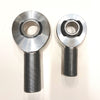How do Heim Joints Work?

Heim Joints
Heim joints, also known as rod ends or spherical bearings, are specialized mechanical components that allow for rotational movement between two objects. They are commonly used in a variety of applications, including automotive, aerospace, and industrial machinery. In this blog post, we'll explore what heim joints are, how they work, and some of their key benefits and drawbacks.
What are Heim Joints?
Heim joints are made up of a spherical ball enclosed within a housing or race. The ball is typically made of steel, while the housing can be made from a range of materials, including aluminum, stainless steel, or plastic. The housing has a threaded stud or shank that allows it to be attached to one object, while the ball allows for rotational movement between that object and another object it is connected to.
How do Heim Joints Work?
When a heim joint is installed between two objects, it allows them to move relative to each other while still maintaining a connection. This is useful in a variety of applications where rotational movement is required, such as steering systems, suspension systems, or control linkages.
The ball within the heim joint is free to rotate within the housing or race, which allows for smooth, low-friction movement between the objects it connects. The housing typically has a range of motion of around 30 degrees in any direction, which allows for a significant amount of movement without binding or damaging the joint.
Benefits of Heim Joints
One of the primary benefits of heim joints is their ability to handle high loads and forces while still allowing for smooth movement. They are commonly used in high-performance applications, such as racing cars, where precise control and reliable operation are essential.
Another benefit of heim joints is their versatility. They come in a range of sizes and styles, making them suitable for a wide variety of applications. They can be used in both static and dynamic environments, and they can be easily adjusted or replaced if needed.
Drawbacks of Heim Joints
One potential drawback of heim joints is their cost. Compared to other mechanical components, they can be relatively expensive. However, their durability and versatility often make them a worthwhile investment in the long run.
Conclusion
Heim joints are a specialized mechanical component that allows for smooth, low-friction rotational movement between two objects. They are commonly used in high-performance applications where precise control and reliable operation are essential. While they can be relatively expensive and require regular maintenance, their versatility and durability make them a valuable investment in many applications.





